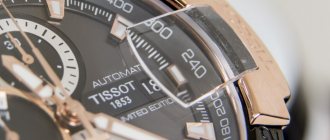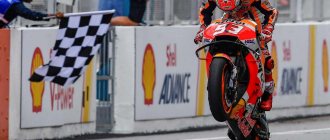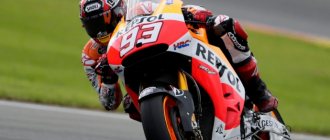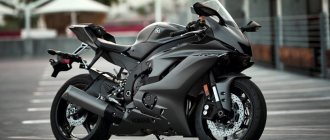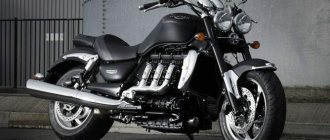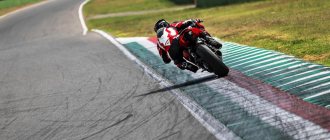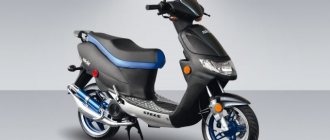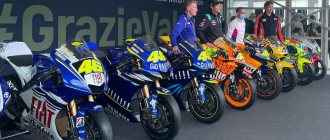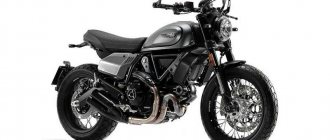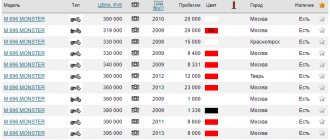The universe was born in one giant explosion. God (the laws of nature, cosmic superintelligence, little green men - cross out what is unnecessary) lit a huge spark plug, and in the cauldron called “The Universe” there was a big bang. A huge amount of cosmic crap, consisting of dust and hydrogen, scattered over many millions of light years, and it eventually stuck together into planets and stars. In a word, the “Big Bang” (“BB”) gave birth to everything that surrounds us, including ourselves. This is one of the theories of the creation of the universe. But the most amazing thing is that in racing technology, the “Big Bang” (just a little smaller) actually produced a colossal revolution, the fruits of which can be seen in MotoGP, BSB, and even in some production sportsbikes.
Despite its V-5 configuration, the engine barely vibrates
For a long time (1) engineers and mechanics have been faced with a problem. Everyone already knew how to obtain large absolute values of power, but making this power accessible turned out to be more difficult. The fact is that with an increase in power, the pilots faced an increasingly acute problem of slipping, especially when exiting corners, and increased tire wear. This was confirmed by telemetry data: the motorcycles easily slipped the rear wheels, which is why many riders simply did not open the gas fully, sometimes not even once during the race! However, not all motorcycles are equally susceptible to this problem. Vehicles with in-line “fours” slid the most, and those with V-tubes slipped less. For this reason, many companies in MotoGP have settled on the V-shape.
Ducati Desmosedici was famous for its high power and tendency to overheat
However, not everyone did this. The fact is that although the V-shape allowed the gas to be opened a little earlier, it also had significant drawbacks. Such engines are noticeably longer than the “in-line” ones, which led to the need to lengthen the base, which is why the motorcycle lost its agility in corners. The cost of V-twin engines is significantly higher than in-line engines - this is an important factor for the team’s budget. Finally, the cost of servicing V-twin engines is also higher. Apparently, these factors saved the life of in-line engines. But problems with character and, as a result, with slippage, remained. It was then, in the nineties, that the idea was born: is it possible to combine the advantages of “row” and “V” engines in one engine?
The classic rower has the same intervals between flashes
At the time, no one really understood why V-twin engines allowed drivers to open the throttle earlier and more when exiting corners. Later, telemetry data and calculations helped to understand why the power of V-twin engines is easier to dose. Let's try to simulate a typical racing situation - getting out of a slow hairpin on a liter sportbike with an inline four. First gear, ten thousand on the tachometer. The total gear ratio (primary gear + first gear of the gearbox + main chain drive) is approximately equal to ten, i.e. For every ten revolutions of the crankshaft, there is one revolution of the rear wheel. In a four-stroke engine, the duty cycle corresponds to 720 degrees, i.e. two revolutions of the crankshaft. This means that in ten revolutions of the crankshaft, five explosions will occur in one cylinder. Multiply by four cylinders and we get 20 explosions per revolution of the rear wheel.
The circumference of the rear wheel is approximately two meters. This means that for each explosion there are ten centimeters of the tire surface - exactly the length of the average contact patch. In the case of an engine with equal intervals between explosions (classic inline-four), it turns out that during slippage, each subsequent explosion occurs just when a new portion of rubber is preparing to replace the slipped contact patch, thus preventing the tire from regaining grip on the asphalt ! Obviously, as the turnover increases, this situation only gets worse.
This is how V-fours work
V-twin engines are a completely different matter. In the case of a V-4 engine with a 90-degree angle between the cylinders (for example, a Ducati Desmosedici), the number of explosions per revolution of the rear wheel will remain the same (20), but there will be two explosions per length of the first (relatively) contact patch. But during the subsequent contact patch there will be no explosions at all! During this lull, the rubber has a much greater chance of regaining reliable grip on the asphalt, which allows riders to be more generous with the gas when exiting corners. It was this double explosion that was called the “Big One”.
“Ryadnik” Yamaha M1 also works using “Big Bang” technology
For those who do not want to plunge into the jungle of BV technology, its essence is easier to understand by imagining the operation of ABS - an anti-lock braking system. To prevent blocking (read: slipping) of the wheels during vigorous braking, the braking force is applied in pulses, in the intervals between which the wheels have a chance to regain grip. “Big Bang” technology is the same ABS system, only in reverse, that is, it reduces slipping not during braking, but during acceleration. Drivers must balance engine power within a razor-thin range when exiting corners. If the power is less, the rider will lose time. If it is more, uncontrolled drift of the rear wheel may occur, which at best will lead to loss of time, and at worst – to a fall. Power from the engine is transmitted to the rear wheel not in a continuous stream, but in pulses. If the pulses are too frequent, they will prevent the tires from maintaining contact with the road, making the driver's task more difficult. But by spreading these impulses out so that there are gaps between them, the rear tire has more opportunity to regain reliable grip and makes it easier for the rider to maintain optimal power.
According to rumors, the Kawasaki ZX-RR was one of the last to switch to the “Big Bang”
What interval between “explosions” will be optimal from the point of view of the traction force of the rear tire with the road? This is the biggest secret of the BV technology. Until now, no one knows exactly what the angle is between explosions in a Yamaha M1 or Kawasaki ZX-RR. But what’s most interesting is that even in motorcycles with V-twin engines, according to rumors in the paddock, the angle between the explosions is not necessarily equal to the camber angle of the cylinders. Experts believe that in the case of the Honda RC211V, angle ranges such as 75.5-284.5 degrees and 104.5-331 degrees are likely between the “Big Bangs”. In the case of the Yamaha M1, angles such as 180-540, 105-255, 255-465, 90-270 and 270-450 degrees are called. The angle between the explosions within the pair forming the “BV” is most likely around ten degrees. However, this is all just guesswork for now.
Implementation of the “Big Bang” in an in-line “four”
Having understood the theory of the racing universe, let's find out how we can organize the “Big Bang” in accordance with the technical standards of MotoGP. The easiest way is to use V-twin engines. Honda, Suzuki and Ducati did this. But as we have already found out, this path is not without its drawbacks. The second way is to make the inline-four work like a V-shaped one. Yamaha and Kawasaki followed this path. In order to achieve the “BV” effect in an in-line engine, the designers had to radically modify their crankshafts, fortunately this is allowed by MotoGP technical standards.
Thanks to the “2+3” configuration, the RC211V frame was made quite narrow
The “row” crankshaft was practically turned into a V-shaped one (except that each connecting rod is still located on a separate journal, and not in pairs, as in the V-4, and there are not three, but five bearings), and installed in the old crankcase with in-line arrangement of cylinders. The resulting vibrations were damped by a balancer shaft. Such an engine is very easy to recognize by its characteristic sound: it does not howl like classic inline-fours, but grumbles almost like a V-4. Apparently for this sound in the paddocks they called him “Growler”.
Another racing series where “BV” is also used is the British Superbike. But in BSB everything is much more complicated, since in accordance with technical standards, modification of the crankshaft is not allowed. However, the Virgin Mobile team has found a way around this limitation in their Yamaha YZF-R1. In accordance with the same rules prohibiting “playing” with the crankshaft, changing the camshafts is allowed. This means that by changing the order of operation of the valves and reprogramming the ignition system accordingly, you can change the order of operation of the cylinders of a conventional inline four. If we discard duplicative or frankly useless options, then there are two ways to simulate “BV” in an engine with a conventional 180-degree crankshaft:
Boom-180-BoomBoom-180-Boom-180-Pause(180)
With this scheme, the internal loads in the engine are small, but the “BV” is less efficient
BoomBoom-180-BoomBoom-180-Pause(360)
Internal loads in the engine increase significantly, but the “BV” effect also intensifies
The first option creates less stress on the piston group and gears, but the “Big Bang” is less effective, and the rear wheel slips only slightly less than usual when accelerating out of corners. The second option, on the contrary, puts more load on the insides of the engine, but more effectively prevents slipping. Which of these two options the team used is still a secret. But, judging by the feedback from Sean Emmett, a pilot of the Virgin Mobile team, it has become easier to drive a superbike with an imitation “BV”, and thanks to this innovation, it was possible to literally find an average of about two seconds per lap out of thin air, and also significantly extend the life of the rear tire.
The V-5 engine fits perfectly into the diagonal frame
Strange as it may sound, the “Big Bang”, albeit partially, has found application in ordinary road motorcycles for quite a long time. Everyone who preferred V-twin engines to in-line engines automatically came closer to the BV technology, but still not knowing the scientific explanation for this effect, they simply rejoiced at the gentler nature of their motorcycles and could talk for a long time about the unique character of their engines. There were attempts to introduce something similar to “BV” into in-line engines. It is unknown whether this is a coincidence or not, but back in the nineties, Yamaha released two motorcycles with in-line engines in which the crankshaft angle was different from 180 degrees. TDM850 and TRX850. Now it is difficult to understand why it was necessary to introduce something like “BV” into an engine with a power of only 73 hp. Perhaps this was a test of the designers' pen, which in 2004 finally became the best motorcycle of the royal class.
V-shaped “five” Honda RC211V with a “big bang”
We motorcyclists live in very interesting times. According to experts, now is the “golden age” of the motorcycle. Technologies that only two or three years ago were available only to the best racers on the planet are now freely available. In pursuit of perfection, designers squeeze every last drop out of iron. And the “Big Bang” technology is the best confirmation of this, because it is, in fact, the result of a deep analysis of the beating “hearts” of modern motorcycles. Scientists and engineers have been able to decipher the fundamental rhythm of a two-wheeled machine. Where racing technology will go in two or three years, only God knows. And we just have to enjoy these fruits while we can.
(1) But still a little later than the moment when the Lord created motorcycle racing and saw that it was amazing how good it was.
Anton Barsukov, photo by the author. Great Britain, 2005
All MotoGP 2022 prototypes
Technology in MotoGP has never been so advanced and the level of technical equipment of prototypes from different factories so equal: Honda, Ducati, Yamaha, Suzuki, KTM and Aprilia - six factories presented their motorcycles before the start of the World Championship in Qatar.
MOTOGONKI.RU, March 16, 2022 - In MotoGP 2022, 6 manufacturers will fight for the right to be called the strongest in the world, three of which are rightfully considered favorites in the fight - the current champion Honda, vice-champion Ducati and the factory that won the title and Cup designers as recently as 2015 - Yamaha.
All MotoGP 2018 prototypes go to photo gallery
Follow the links below the images to be taken to detailed photo galleries detailing each bike! Or just go to the MOTOGONKI.RU Photo Galleries
Honda RC213V
Of all the teams, only Honda prepared for the Qatar Grand Prix without any complaints. The fact that everything was OK became clear back in February, at ThaiTest, following which Repsol Honda reported: Honda is 100% ready for battle! The RC213V remains the most balanced prototype of all: it is so powerful that the aggressive engine has to be “extinguished” by electronics!
MotoGP - Honda RC213V (2018) go to photo gallery
This prototype is equipped with a 1000 cc V4 engine. with a real power of about 280 hp. The chassis is built on an aluminum frame consisting of hollow blocks of variable cross-section, welded into a single structure with an unrivaled ratio of rigidity and flexibility. HRC uses Ohlins brakes and late model Brembo brakes. In 2022, there will be even more carbon parts in the chassis elements.
MotoGP - Honda RC213V (2018): note the completely different fairing designs for Marquez and Pedrosa go to photo gallery
As the season progresses, it is planned to replace the aluminum rear wheel swingarm with a full carbon one to give the chassis even more rigidity. It is this rigidity that is the main problem for beginners to master the Honda prototype. But if they cope, further steps in MotoGP are taken quickly.
Specifications and photos of Honda RC213V (2018)
Ducati Desmosedici GP18
The evolutionary version of the D16 (“D” - Desmo, “16” - Sedici (Italian: “sixteen”) became an improved version of last year’s Ducati prototype, which even then could compete with Honda in direct battles, where the fate of victory was often determined by the skill of the pilot. Both prototypes provide approximately equal peak speed and power, Ducati became more stable under braking, and the factory engineers managed to almost completely eliminate the traditional D16 problem with understeering or “sluggishness”: it was expressed in the fact that the rider had to resort to more effort to make the bike go along the trajectory in the turn - he tried to jump out.
MotoGP - Ducati Desmosedici GP18: right view go to photo gallery
Ducati was the first to use winglets or flaps - external aerodynamic elements that help improve downforce on the front wheel. This reduces the risk of wheelie, improves braking quality and reduces losses when opening the gas suddenly.
MotoGP – Ducati Desmosedici GP18 Jorge Lorenzo go to photo gallery
The D16 uses a 1000 cc V4 engine. and a power of more than 265 hp. Ducati holds a number of all-time MotoGP top speed records, including 354.9 km/h (Andrea Iannone, Ducati GP16).
Technical specifications and photos of the Ducati Desmosedici GP18 (2018)
Yamaha YZR-M1
The M1 project began to be developed in 2002, but only with the arrival of Valentino Rossi at Yamaha Factory Racing did the motorcycle begin to bring victories. That's why Rossi's involvement in the M1 project is so valuable: Valentino has extended his contract with the factory for another 2 years, so he will spend 15 years together with Yamaha (2018 will be his 13th with Yamaha and 23rd in his career).
MotoGP – Yamaha YZR-M1 (2018) go to photo gallery
In 2015, the motorcycle was ready to win the championship during the tests in Sepang, at the very end of January. The factory knew about this and therefore the Triple Crown in Valencia was taken for granted: Loretzno took the title, Rossi became vice-champion, Yamaha Factory Racing became the best team, and Yamaha became the best manufacturer. But the 2022 season did not work out. In the middle of the season, Rossi and Vinales, who started the year close to ideal, suddenly began to experience difficulties - they could not control the wear of the rear tire due to constant slipping. Electronic tuning and power limitation did not help, but only reduced the potential of the motorcycle. Rossi devoted the whole year to finding a solution and eventually came to the decision to roll back to using the 2016 chassis. Based on this model, the YZR MY18 was born.
MotoGP - Yamaha YZR-M1 (2018) Valentino Rossi go to photo gallery
The M1 is built around a 1000cc inline 4-cylinder engine. and a power of more than 250 hp, installed in an aluminum frame with ideal geometry and a “triangle” of force distribution, as well as close to ideal weight distribution. These features imply extremely smooth, soft piloting - “Lorenzo style”. Valentino Rossi has changed his style many times throughout his career to suit today's standards, and this has not always had a positive effect on the result. But the motorcycle was always tuned taking into account its needs. The M1's strength is its unmatched precision when cornering and braking before corners. The bike simply has no weaknesses. It all depends on the correct application of the pilot's efforts.
All technical specifications and photos of Yamaha YZR-M1 (2018)
Suzuki GSX-RR
This will be Suzuki's 4th season back in MotoGP with the latest prototype built from the ground up around a 4-cylinder in-line engine producing over 240 hp. There is still some power and peak speed shortfalls, but by 2022 the GSX-RR has reached the level of top class prototypes such as Yamaha and Ducati, and now the factory team's pilots can easily compete for a place on the podium.
MotoGP - Suzuki GSX-RR (2018) go to photo gallery
Suzuki GSX-RR is considered the next contender to take victory in the Grand Prix. In 3 years, engineers from Hamamatsu were able to make a very well-balanced prototype with an original seamless transmission. The frame, like the Honda, consists of variable-section aluminum blocks and is built according to traditional sportbike principles.
MotoGP - Suzuki GSX-RR (2018) go to photo gallery
Suzuki continues to experiment with winglets. The plant was supposed to homologate the latest version of the aerodynamic body kit yesterday in Qatar. The first photos of the actual motorcycle will appear with the opening of FP1 after 13:00.
Full technical specifications and photos of Suzuki GSX-RR (2018)
KTM RC16
The fastest growing MotoGP prototype was created from scratch just 2 years ago and debuted in the Royal Class in March 2017. And by September, all three pilots of the factory team - Espargaro, Smith and Kallio - were able to finish inside the TOP-10, which was clearly not expected by either the factory or their rivals.
MotoGP - KTM RC16 (2018): three factory pilots - Espargaro, Kallio, Smith go to photo gallery
The motorcycle is built on the original 1000 cc V4 engine. and a power of more than 265 hp, which was achieved back in 2016. The main difference between the RC16 and Japanese and Italian motorcycles is the use of a steel tubular birdcage frame made of rigid chromoly tubing - a KTM hallmark. And the suspensions, unlike others, are used by WP, a subsidiary of KTM, also located in Austria, in the industrial conglomerate of Mattighofen, where all the company’s production facilities, as well as the new home of KTM Factory Racing, are concentrated 2-3 km from the headquarters and the WP Suspension plant.
MotoGP - KTM RC16 (2018) go to photo gallery
In 2022, the prototype has changed only internally. Therefore, it would be more correct to give the technical characteristics of that particular model, but one cannot help but talk about the improvements of the 2022 model. Read more: KTM RC16 (2018) – New colors, same approach
Technical specifications of KTM RC16 (2017/18)
Aprilia RS-GP
The birth of the Aprilia prototype was painful. At the 2014 Valencia tests, Marco Melandri, Alvaro Bautista and Tony Hofmann tested three completely different prototypes, and it was not until March 2015 that the factory decided on a name. The RS-GP we know didn't appear until a year later, at the IRTA tests in Sepang at the end of January 2016.
MotoGP - Aprilia RS-GP (2018): Scott Redding and Ales Espargaro go to photo gallery
Over the course of two seasons, the bike has been transformed: it has acquired a new frame, a seamless transmission of its own design, updated valve drive pneumatics (the hallmark of the Aprilia RS series) and a completely carbon swingarm. Today this is a completely competitive bike, capable of finishing in the TOP-5 on most tracks on the MotoGP calendar.
MotoGP - Aprilia RS-GP (2018) go to photo gallery
In 2022, the factory expects to take at least one victory and fight for a place on the podium with Ales Espargaro, again on selected tracks. The 1000 cc V4 from Noale still lacks peak speed, although its stated power exceeds 270 hp.
Technical specifications and photos of Aprilia RS-GP (2018)
Failure of Rossi, Yamaha and Ducati
In the absence of Marquez, an unpleasant surprise was the lack of speed among the pilots of the factory Yamaha and Ducati - only one race won by Maverick Viñales on the account of Monster Energy Yamaha MotoGP and two victories for the Ducati Team, won by Andrea Dovizioso and Danilo Petrucci.
Not a single victory for Valentino Rossi, who was content with a single podium during the season, not a single victory for the Repsol Honda Team. With the latter, everything is clear - the loss of the team’s favorite immediately put an end to the team’s championship ambitions, since the departure of Jorge Lorenzo at the end of the 2019 season and the signing of a contract out of despair with Alex Marquez, a MotoGP debutant, clearly did not contribute to the fight for high positions.
It seems that the Yamaha pilots were not satisfied with the new motorcycle, the engine of which also turned out to be not the most reliable, which led to proceedings at the end of the season and the loss of points in the team competition. In the Ducati Team, traditionally the bike turned out to be not the easiest and friendliest for pilots, and the situation was further aggravated by the new Michelin tires, which were difficult to warm up, and the pilots themselves had to change their driving style, all to no avail. Plus, the contract issue remained unresolved for a long time, and in conditions of uncertainty in the future, and even more so after it became clear that neither Dovizioso nor Petrucci would remain in the team for the next season, it was difficult for the pilots to find motivation to develop the motorcycle.
Related news
MotoGP pilot Iannone, who appealed his doping ban, received an even greater punishment
The Doctor's failure can partly be explained by the same thing. Rossi became the only MotoGP pilot diagnosed with coronavirus, which forced Valentino to miss both races in Aragon, but even without this, the season became a failure for the titled Italian. Having won his 199th career podium in MotoGP, Rossi seemed to be under a spell - he could not achieve his 200th top-3 finish, much less his 90th victory in the top class.
But the 41-year-old driver does not intend to hang up his helmet - yes, the factory team, after 15 years of cooperation with Valentino, did not renew his contract, preferring the young talent Fabio Quartararo
, but Rossi was not left completely without a place. He went to the private Petronas Yamaha SRT to take the place of the French pilot - the “Doctor” was promised a motorcycle in factory specification and full support from the factory, so in the absence of gigantic pressure, the Italian may well present a pleasant surprise in 2022.
Examples of this can be found in the past season, where in the absence of a clear leader, whose total dominance demotivated everyone else, those who vegetated in secondary roles were able to express themselves.
Frightening accident in MotoGP: the legendary Rossi was almost hit by a bike at a speed of under 300
